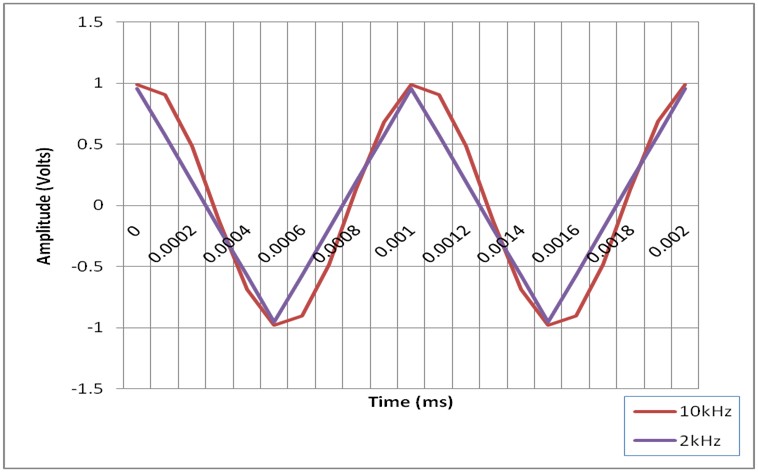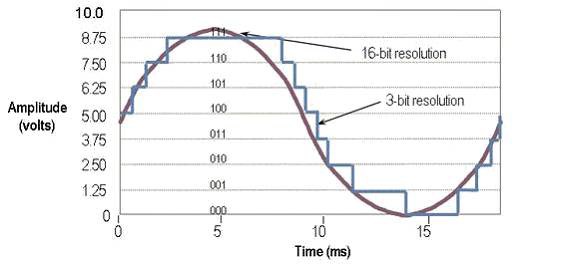How to Choose the Right DAQ Hardware for Your Measurement System
Overview
5 Questions to Guide You in Choosing the Right DAQ Hardware
- What types of signals do I need to measure or generate?
- Do I need signal conditioning?
- How fast do I need to acquire or generate samples of the signal?
- What is the smallest change in the signal that I need to detect?
- How much measurement error does my application allow?
1. What types of signals do I need to measure or generate?
Different types of signals need to be measured or generated in different ways. A sensor (or transducer) is a device that converts a physical phenomenon into a measurable electrical signal, such as voltage or current. You can also send a measurable electrical signal to your sensor to create a physical phenomenon. For this reason, it is important to understand the different types of signals and their corresponding attributes. Based on the signals in your application, you can start to consider which DAQ device to use.
Functions of DAQ Devices
- Analog inputs measure analog signals
- Analog outputs generate analog signals
- Digital inputs/outputs measure and generate digital signals
- Counter/timers count digital events or generate digital pulses/signals
There are devices that are dedicated to just one of the functions listed above, as well as multifunction devices that support them all. You can find DAQ devices with a fixed number of channels for a single function, including analog inputs, analog outputs, digital inputs/outputs, or counters; however, you should consider purchasing a device with more channels than you currently need so that you can increase channel count if necessary. If you purchase a device that only has the capabilities for your current application, it will be difficult to adapt the hardware to new applications in the future.
Multifunction DAQ devices have a fixed channel count, but offer a combination of analog inputs, analog outputs, digital inputs/outputs, and counters. Multifunction devices support different types of I/O, which gives you the ability to address many different applications that a single-function DAQ device would not.
Another option is a modular platform that you can customize to your exact requirements. A modular system consists of a chassis to control timing and synchronization and a variety of I/O modules. An advantage of a modular system is that you can select different modules that have unique purposes, so more configurations are possible. With this option, you can find modules that perform one function more accurately than a multifunction device. Another advantage of a modular system is the ability to select the number of slots for your chassis. A chassis has a fixed number of slots, but you can purchase a chassis that has more slots than you need now to give you the ability to expand in the future.
2. Do I need signal conditioning?
A typical general-purpose DAQ device can measure or generate +/-5 V or +/-10 V. Some sensors generate signals too difficult or dangerous to measure directly with this type of DAQ device. Most sensors require signal conditioning, like amplification or filtering, before a DAQ device can effectively and accurately measure the signal.
For example, thermocouples output signals in the mV range that require amplification to optimize the limits of the analog-to-digital converters (ADCs). Additionally, thermocouple measurements benefit from lowpass filtering to remove high-frequency noise. Signal conditioning provides a distinct advantage over DAQ devices alone because it enhances both the performance and measurement accuracy of DAQ systems.
Table 1 provides a summary of common signal conditioning for different types of sensors and measurements.
| Amplification | Attenuation | Isolation | Filtering | Excitation | Linearization | CJC | Bridge Completion | |
| Thermocouple | x | x | x | x | ||||
| Thermistor | x | x | x | x | ||||
| RTD | x | x | x | x | ||||
| Strain Gage | x | x | x | x | x | |||
| Load, Pressure, Torque (mV/V, 4-20mA) | x | x | x | x | ||||
| x | x | x | x | |||||
| Accelerometer | x | x | x | x | ||||
| Microphone | x | x | x | x | ||||
| Proximity Probe | x | x | x | x | ||||
| LVDT/RVDT | x | x | x | x | ||||
| High Voltage | x | x |
Table 1. Signal Conditioning for Types of Sensors and Measurements
If your sensor is listed in Table 1, you should consider signal conditioning. You can add external signal conditioning or choose to use a DAQ device with built-in signal conditioning. Many devices also include built-in connectivity for specific sensors for convenient sensor integration.
3. How fast do I need to acquire or generate samples of the signal?
One of the most important specifications of a DAQ device is the sampling rate, which is the speed at which the DAQ device’s ADC takes samples of a signal. Typical sampling rates are either hardware- or software-timed and are up to rates of 2 MS/s. The sampling rate for your application depends on the maximum frequency component of the signal that you are trying to measure or generate.
The Nyquist Theorem states that you can accurately reconstruct a signal by sampling two times the highest frequency component of interest. However, in practice, you should sample at least 10 times the maximum frequency to represent the shape of your signal. Choosing a DAQ device with a sample rate at least 10 times the frequency of your signal ensures that you measure or generate a more accurate representation of your signal.
For example, suppose in your application you want to measure a sine wave that has a frequency of 1 kHz. According to the Nyquist Theorem, you must sample at 2 kHz at least but it is highly recommended to sample at 10 kHz to measure or generate a more accurate representation of your signal. Figure 1 compares a 1 kHz sine wave measured at 2 kHz and 10 kHz.
Figure 1. 10 kHz Versus 2 kHz Representation of a 1 kHz Sine Wave
Once you know the maximum frequency component of the signal that you want to measure or generate, you can choose a DAQ device with the appropriate sampling rate for the application.
4. What is the smallest change in the signal that I need to detect?
The smallest detectable change in the signal determines the resolution that is required of your DAQ device. Resolution refers to the number of binary levels an ADC can use to represent a signal. To illustrate this point, imagine how a sine wave would be represented if it were passed through an ADC with different resolutions. Figure 2 compares a 3-bit ADC and a 16-bit ADC. A 3-bit ADC can represent eight (23) discrete voltage levels. A 16-bit ADC can represent 65,536 (216) discrete voltage levels. The representation of the sine wave with a 3-bit resolution looks more like a step function than a sine wave where the 16-bit ADC provides a clean-looking sine wave.
Figure 2. 16-Bit Resolution Versus 3-Bit Resolution Chart of a Sine Wave
Typical DAQ devices have voltage ranges of +/-5 V or +/-10 V. The voltage levels that can be represented are distributed evenly across a selected range to take advantage of the full resolution. For example, a DAQ device with a +/-10 V range and 12 bits of resolution (212 or 4,096 evenly distributed levels) can detect a 5 mV change, where a device with 16 bits of resolution (216 or 65,536 evenly distributed levels) can detect a 300 µV change. Many application requirements are met with devices that have 12, 16, or 18 bits of resolution. However, if you are measuring sensors with small and large voltage ranges, you can likely benefit from the dynamic data range available with 24-bit devices. The voltage range and resolution required for your application are primary factors in selecting the right device.
5. How much measurement error does my application allow?
Accuracy is defined as a measure of the capability of an instrument to faithfully indicate the value of a measured signal. This term is not related to resolution; however, accuracy can never be better than the resolution of the instrument. How you specify the accuracy of your measurement depends on the type of measurement device. An ideal instrument always measures the true value with 100 percent certainty, but in reality, instruments report a value with an uncertainty specified by the manufacturer. The uncertainty can depend on many factors, such as system noise, gain error, offset error, and nonlinearity. A common specification for a manufacturer’s uncertainty is absolute accuracy. This specification provides the worst-case error of a DAQ device at a specific range. An example calculation for a National Instruments multifunction device’s absolute accuracy is given below:
Absolute Accuracy = ([Reading*Gain Error] + [Voltage Range*Offset Error] + Noise Uncertainty)
Absolute Accuracy = 2.2 mV
It is important to note that an instrument’s accuracy depends not only on the instrument, but also on the type of signal being measured. If the signal being measured is noisy, the measurement’s accuracy is adversely affected. There are wide ranges of DAQ devices with varying degrees of accuracy and price points. Some devices may provide self-calibration, isolation, and other circuitry to improve accuracy. Where a basic DAQ device may provide an absolute accuracy over 100 mV, a higher performance device with such features may have an absolute accuracy around 1 mV. Once you understand your accuracy requirements, you can choose a DAQ device with an absolute accuracy that meets your application needs.
Next Steps:
- Download the complete guide to building a measurement system
- Choose the right bus for your measurement system
- Choose the right computer for your measurement system
- Choose the right driver software for your measurement system
- Choose the right application software for your measurement system
- Choose the right visualization techniques for your measurement system

